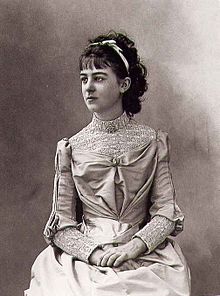|
Élisabeth de Gramont
Antoinette Corisande Élisabeth, Duchess of Clermont-Tonnerre (née de Gramont; 23 April 1875 – 6 December 1954)[1] was a French writer of the early 20th century, best known for her long-term lesbian relationship with Natalie Clifford Barney, an American writer. Élisabeth de Gramont had grown up among the highest aristocracy; when she was a child, according to Janet Flanner, "peasants on her farm... begged her not to clean her shoes before entering their houses". She looked back on this lost world of wealth and privilege with little regret, and became known as the "red duchess" for her support of socialism and feminism.[2] She was a close friend, and sometimes critic of writer Marcel Proust, whom she first met in 1903. Early lifeAntonia Corisande Élisabeth de Gramont was born on 23 April 1875 in Nancy, France. Called "Lily", she was the daughter of Agénor de Gramont, 11th Duke of Gramont, and his first wife, née Princesse Isabelle de Beauvau-Craon.[3] Her mother died giving birth to her. Her father soon married again to the wealthy Marguerite de Rothschild.[3] Gramont was educated for her class. She later participated in Popular Front parades, and supported politicians of the left. Personal life In 1896, Élisabeth married Aimé François Philibert, 8th Duke of Clermont-Tonnerre (1871–1940), a son of Gaspard Aimé Charles Roger, 7th Duke of Clermont-Tonnerre and Françoise Béatrix de Moustier. He owned several estates, including the Château de Glisolles in the Eure department. Before their divorce in 1920,[4] they had two daughters together:[5]
In 1921, she sued the Duke alleging that he "wrongfully appropriated many valuable works of art and detained for his own uses 3,500,000 francs of her money."[8] She died in Paris on 6 December 1954, outliving her former husband and both daughters, and is buried at Ancy-le-Franc, near the family Château de Clermont-Tonnerre. Natalie Barney American writer Natalie Barney and Duchess de Clermont-Tonnerre first met in the spring of 1909; they became lovers on 1 May 1910, a date that they celebrated as their anniversary.[9] Although neither was faithful to the other sexually, they were devoted to one another for their entire lives. Elisabeth's husband is said to have been violent and tyrannical.[citation needed] The Duchess accepted Barney's ways—perhaps reluctantly at first—and went out of her way to be gracious to Barney's other lovers. For example, the Duchess always included Romaine Brooks when she invited Barney to vacation in the country. Brooks and Barney developed a strong relationship about 1916, and both de Gramont and Brooks had to live with Barney's infidelity. But the three women eventually formed a kind of trio and were devoted to one another for the rest of their lives. On 20 June 1918 Barney and De Gramont filed an "unofficial" but, at least to them, binding "marriage contract". The contract stated, in part;
In essence, the contract was to bind them together, at least in their own minds, but did not require them to being only with one another sexually. The contract was honored by both until the Duchess' death in 1954. Bibliography
References
SourcesDiana Souhami (2007). Wild Girls: Paris, Sappho, and Art: The Lives and Loves of Natalie Barney and Romaine Brooks. Macmillan. ISBN 978-0-312-36660-5. External links |
||||||||||||||||||||||||
